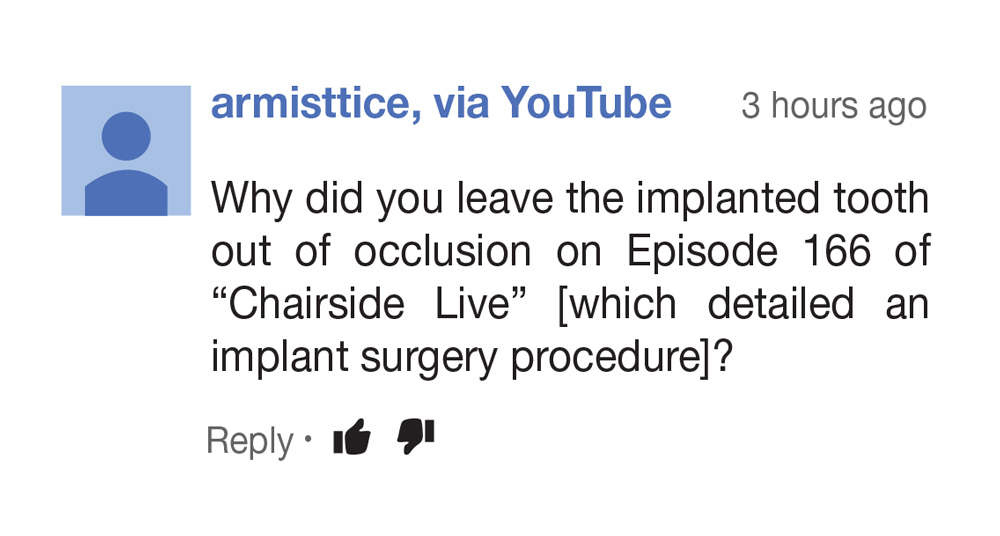Case Queries
Dear “armisttice,”
A lot of doctors already know there is a major difference between natural teeth and implants in terms of the way that the implant or natural tooth comes into contact with the underlying bone. Natural teeth are surrounded by the periodontal ligament, which goes all the way down into the alveolar process. That is called a gomphosis, which is essentially a joint between the natural tooth and the alveolar process. For an implant, there is a solid connection between the implant and the bone, and that connection does not move. We call that a synarthrosis, but that is sometimes a misnomer — it should really be called an ankylosis. Based on that foundation, when we restore single posterior teeth, we usually keep the tooth out of occlusion by a slight margin. I usually use one layer of shim stock, and when I check the occlusion, I make sure the tooth is out of occlusion.
However, things get very complicated when multiple implants and different scenarios are involved. For example, if you have a single tooth and it’s surrounded by many teeth in the arch, we can leave that tooth out of occlusion slightly. If we have multiple teeth — for example, a 3-unit bridge that’s being held by two implants — what does the clinician have to do? Based on my experience, I’ve usually found that when I deliver this restoration, the patient will tell me they can feel it if it’s in occlusion. So, similar to delivering a regular 3-unit fixed dental prosthesis on natural teeth, I usually deliver the restoration and take it out of occlusion slightly as I would for a single unit implant crown.
If a patient is scheduled for lifelong checkups on an every-six-months basis, but cannot make an appointment, theoretically the opposing tooth may super erupt and result in the implant crown being in occlusion. The concern is that with a zirconia material, there may be too much rigidity to the opposing dentition, resulting in prosthetic complications. In these instances, porcelain may appear to be a more protective option compared to zirconia. However, implant dentistry and occlusion are multifactorial in terms of the long-term success of the restoration. One of those factors is the occlusal table — specifically, the buccolingual width of the tooth and the type of loading that we can have on top of the implant. When we load an implant restoration, we want to keep the occlusal table very narrow on the restoration so that the forces are compressive and go through the long axis of the implant. Regarding the type of restoration, I have placed a lot of BruxZir® restorations on my implants. The reason I do that is because of studies like the ones coming from Drs. Gordon and Rella Christensen that have shown a favorable response of zirconia versus natural tooth structure or opposing natural tooth structure. I’ve felt very comfortable with the occlusal scheme, and I’ve been able to restore cases with confidence. The gradual super-eruption of the opposing tooth is a factor in determining when to address the tooth and whether to bring the patient back every six months. I would also like to cite Dr. Carl Misch, who mentioned in several papers that there is something called progressive occlusal loading. He states that if you immediately load the implant, you might have some forces that result in cervical bone loss around the implant. Over time, it’s OK to progressively load the implant, so, as the opposing tooth is erupting, this scenario may actually be favorable in terms of prevention of bone loss around the implant.
– Dr. Abai



